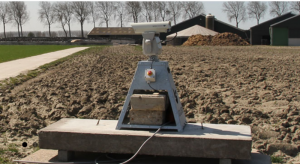
Jim Griffin, the owner of Griffin’s Lair in Sonoma County,has a 21 acres of vineyard. Annually these suffer bird damage to the grape crops. To combat bird predations he used to spend around US$25K each year on netting and labor to try to dissuade the birds. The problem was that such traditional methods are labor-intensive … and didn’t solve the bird problem. For example, the biggest disadvantage of bird netting is that it is not effective for areas where many birds are foraging or perching. The birds still can get under the net and damage the grapes. The net also makes it difficult to work on the grapes for annual pruning, fertilizing or removing damaged grapes.

“We tried many different bird deterrent measures but most are difficult to use, and lasers make it easier and very effective.” says vineyard owner Jim Griffin.
The scale of the problem
Bird problems make the grape growers suffer losses in the millions of dollars every year. According to the research done by A. Anderson, C.A. Lindell, K.M. Moxcey and others, California and Washington states have the biggest grape damage caused by birds. They have calculated this at some US$49M for California and US$13M for Washington.
Current yield-loss percentage due to bird damage in grape growing in California is 2.9 % per year. The birds responsible for damage to grapes include American Robins and European Starlings.
Apply lasers to scare birds
Though not previously deployed in California, other vinyards around the world use automated lasers like the Agrilaser Autonomic. These include:
- Devonian Coast Wineries in Canada
- Bodega Catena Zapata in Argentina
- Summerhill Road Vineyard in Australia.
After having contacted Bird Control Group, Jim Griffin installed four solar powered lasers on poles. These cover the entire vineyard.
The laser bird deterrent technology takes advantage of a bird’s natural instincts. Birds perceive an approaching laser beam as a predator and take flight to seek safety when the laser beam passes by. There are now more than 6,000 users of bird deterrent lasers worldwide.
Enterprise Times: what does it mean
Birds are a problem for wine makers. They are also a pest for several other industries, including:
- aviation
- other (non grape) agricultureproducts
- fishing and acquaculture
- oil and gas
- recreation
- real estate
- renewable energy.
To illustrate this, customers of Bird Control Group, which sold the Griffin’s Lair installations, include Portland International Airport, Shell and Total. In each case the objective is keeping birds away.
For Enterprise Times this is an instance of lateral thinking. In the context of aviation, for example, lasers are normally thought to be dangerous – with stories abounding of pilot sight damaged by rogue laser users on the ground. With solar powered devices like the Agrilaser Autonomic, it is possible to deter pests without deploying chemicals or intensive labour.



























The main problem with this technology is that it is NOT automated. It must be operated by a person or be in direct FAA violation. Laser light will travel for miles and has the potential for causing blindness and mayhem if left unchecked. I know of better eco friendly methods being used to control pest birds that don’t need to be manned to operate safely.
Dear Timothy,
Thank you for your comment. We do have an automatic solution and installed these Agrilaser Autonomic bird deterrent lasers at farms, industrial sites and multiple airports. We maintain safe operation using remote controls, passwords, key locks, deployment in a controlled area, thorough assessments and safety training. Our patented bird repellent robot allows you to determine the area where the laser beam will project and the patented Projection Safety System (PSS) prevent the laser beam from leaving that area.
Bird Control Group worked with Portland International Airport to get approval from FAA for the use of our bird deterrent lasers. We also work with airports in other countries like Gatwick Airport, Frankfurt Airport and Singapore Changi Airport. As a leading company in bird deterrent lasers it is our mission to make our products ultra safe while maintaining maximum effectiveness, animal friendliness and prevent habituation. An example of this leading role is our contribution to the Civil Aviation Authority CAP 772 guidelines for bird strike prevention at airports.
If you are interested to talk further or discuss partnership opportunities, feel free to contact us at http://www.birdcontrolgroup.com
Has there been a study to determine if the lasers are blinding birds?
I found and read an article about the Audubon Society’s use of lasers to deter migratory birds from a toxic pool at an old mine. There was no information about whether or not the lasers were blinding birds. There were safety protocols in place, “in order to avoid accidentally temporarily blinding a pilot flying a commercial plane to or from the municipal airport.” I guess in the case where drinking toxic water surely lead to the birds demise, the possibility of blinding a few birds was worth the risk. However, here we are talking about protecting wine grapes. Is the possibility of blinding some birds worth the reduced cost of protecting some wine grapes from being eaten.
If anyone knows of a study as to whether or not birds are being blinded, please post it.